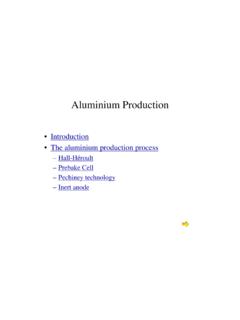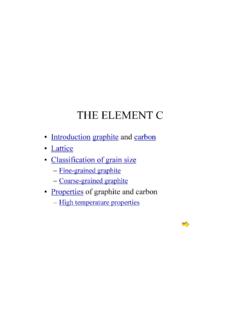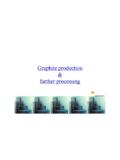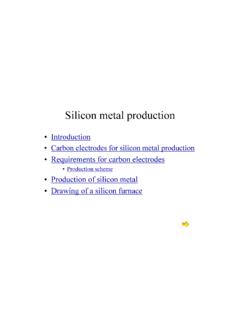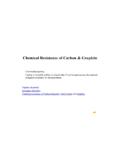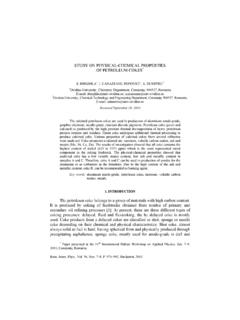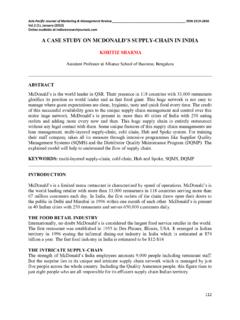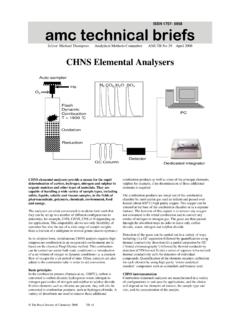Transcription of Introduction Cokes - Carbon and Graphite
1 Raw Materials Introduction Cokes Petroleum coke Green coke Pitch coke Metallurgical coke Carbon black Needle coke Binders Coal tar pitch Petroleum pitch Phenolic resins Cellulose compounds Furan orfurfurylalcoholresins IntroductionArtificial Graphite is manufactured from cokeand Petrographic Atlas Naturally occurring raw materials are natural graphiteand is a solid high in content of the element Carbon and structurally in the NON-GRAPHITIC STATE: It is produced by pyrolysisof organicmaterial which has passed, at least in part, through a liquid orliquid-crystalline state during the CARBONIZATION process. coke can contain mineralmatter.
2 Click here for coke grades. The production processof Material for Carbon / Graphite ProductsGE/NIPCARBON LININGSECA (*)Pet cokePet cokeECA (*)Pet cokeECA (*)Pet cokeDry Raw MaterialsPitchPitchPitchPitchBinders(*) various gradesCoke Production485-505 CDewateringof green cokeDelayed coking1200 -1350 CRotary kilnStorage&ShipmentCoolingNeedle coke ProductionCoalCrude oilCokinDistillation&ConversionGasgMetal l. cokeTarDistillationVR/Decant oil/Thermal tarDelayed CokingCalciningSoft pitchSoft pitchPetroleum derivedneedle cokeCoal tar pitch needle cokeCokegradesCOKINGF luid CokingFlexi CokingDelayed CokingGRADEF luid CokeFuel CokeAnode CokeNeedle CokeCokesCoke is a synthetic raw material used for producing carbonin combination with binding agents(or binders).
3 There are different kinds of coke , petroleum coke , pitch coke , metallurgical coke , Carbon black, needle a summary of their characteristic date click here. Characteristic data Petrol coke Pitch coke Metallurgical coke Density at 1300 C (g/m ) - Missing Ash (%) Missing Sulphur (%) Missing CTE (10-6/K) Missing CTE: Coefficient of Thermal Expansion, determined from coke grain after heating to 2800 C Standard Properties of cokeCoefficient ofThermal Expan-sionCTE:most important quality factor because the electrode CTE mostly influences material behaviorXyleneDensity:gives a rough idea about the coke quality but depends on calciningconditions (temperature)H-content:gives information on calciningtemperatureS-content.
4 Gives information on puffing (N-content in case of CTP Cokes )VBD: gives information on the packing densityAsh: gives information on the feedGraphitizability calculated structural index from microscopy analysis, Index: strongly correlated with CTED ifferent kind of cokesPetroleum coke (picture)Petroleum coke , as far as quantity is concerned, is the most important raw material, and it is formed in a wide range of structures -from highly anisotropic needle coke to nearly isotropic fluid coke . The highly anisotropic needle coke , due toits structure, is indispensable for the manufacture of high-performance electrodes used in electric arc furnaces, where a very high degree of electrical, mechanical andthermal load-bearing capacity is required.
5 For fine-grainedgraphites, it plays a less significant role, since its highly ordered structure is destroyed by the crushing and milling operations which are used to obtain a powder with the required low grain size. Petroleum coke is almost exclusively produced by the delayed coking process, which is a mild slow carbonising procedure of crude oil distillation residues. Click herefor the table comparing the characteristics of petrol, pitch and metallurgical kind of cokesGreen cokeWhen petroleum coke is produced by the delayed coking process which is a mild slow carbonising procedure of crude oil distillation residues, it is called green or raw coke .
6 It still contains considerable amounts (approximately 5 to 12%) of aliphatic constituents, hydrogen and heteroelements; which, at elevated temperatures, are set free as volatile matter. This mass loss leads to high shrinkage of the coke and to the formation of pores and cracks, which generally rules out a direct processing of green coke to shaped artefacts. Therefore, they are mixed with either a coal tar pitch of relatively low viscosity or an anthracene-oil refluxed pitch or a crude tar. The green coke is calcined at1200 to 1400 C mainly in rotating kilns or hearths.
7 During this treatment thevolatile constituents of the coke are reduced to less than Different kind of cokesPitch cokePitch coke is manufactured from thermally treated coal tar pitch either by using the delayed coking process, or by means of conventional coking procedures. Its structure is less ordered than petroleum coke , but its strength and hardness are higher. Click herefor the table comparing the characteristics of petrol, pitch and metallurgical of pitchCharacterizationTypical propertiesFunction of binder pitchFunction of Binder Pitch Plastifies the green mix, thus permitting the body to be shaped (by extrusion, moulding, ); Acts as a binder in the green body: glues the mix dry components; Acts as a binder in the baked artefact as pitch coke and connects the dry components definitively.
8 The amounts of pitch required depends on the property of filler material and grain of binder pitch-Prebaked anodes-S derberg anodes-Ramming paste-Cathodes-Aluminiumindustry-Electri c Steel Industry- Graphite electrodes-SpecialityApplication-Clay pigeons-Refractory bricks-Brushes-Specialy Graphite - Carbon electrodes-Fibres- Carbon / Carbon composites-Calcium carbide-Arc Carbon (welding)-High temp. processingof metals, glassandceramics-Mechan. graphitePitch Characterizationhomogeneous phase composedof several hundreds compounds(multi-ringed aromatics&heteroaromatics)30 % can be identified onlySolid phase(quinoline insolubles, QI)Pitchsootspherulitic Carbon -primaryQI-normal QI-pyrolytic Carbon -pitch coke -carry-overcenospherescokecoalminera l matter-secondaryQI-carbonaceousmesophase Typical Properties of PitchBinder PitchImpregnation PitchSofteningpoint (M) C83 -11565 -90QI %5 -131 -5TI %24 -3314 -20 Coking value%50 -6042 -48 Viscosity(150 C) mPas1206 -4500300 1200 Different kind of fillersCarbon black (picture)
9 In contrast to the soot formed under normal combustion conditions, industrial Carbon blacks, with maximum particle diameters of several nanometres, are produced on a large scale at considerably higher temperatures. They are practically free fromphysiologically hazardous polycyclic aromatic hydrocarbons (PAHs). These blacks have a very fine particle size, which makes them unsuitable for processing directly into solid , they are mixed with either a coal tar pitch of relatively low viscosity or an anthracene-oil refluxed pitch or a crudetar of high viscosity or a mixture of these substances to give a plastic material which is formed by tamping or extruding into bale or noodle-shaped bodies that can be processed more easily.
10 These petroleum artefacts are baked and calcined at temperatures between 1200 and 1400 C. The material thus produced is called Carbon black or lamp black coke and may be used the same way as petroleum, metallurgical, green, or pitch coke . This relatively expensive manufacture of a raw material is justified by some very special properties of the product obtained. The very low microcrystalline order of the Carbon black is not significantly improved even by graphitisation. Especially the crystalline growth along the a-axis remains limited, so that the graphitised Carbon black coke retains its microcrystallinity already set by the initial particle size of the Carbon black.
